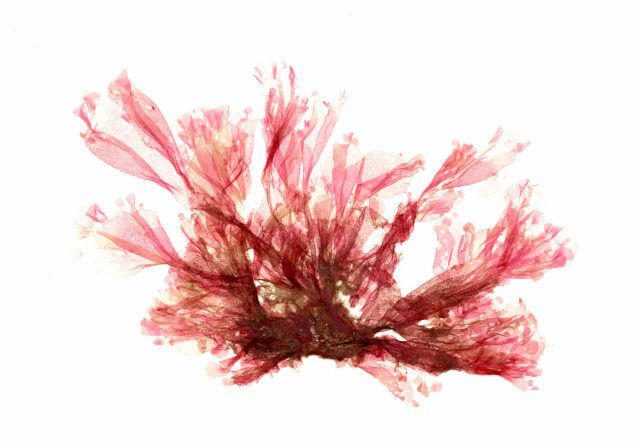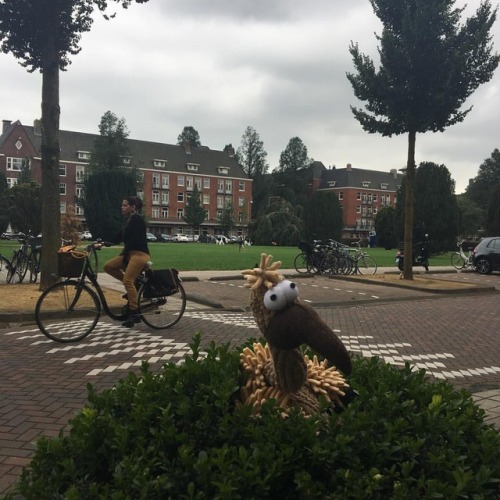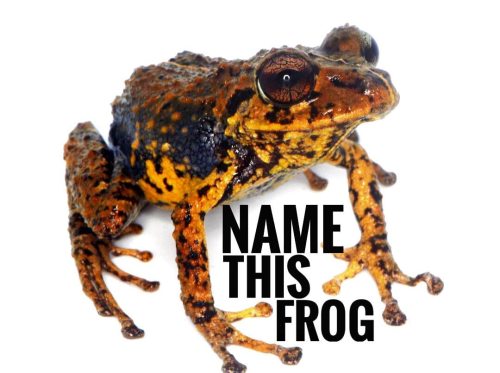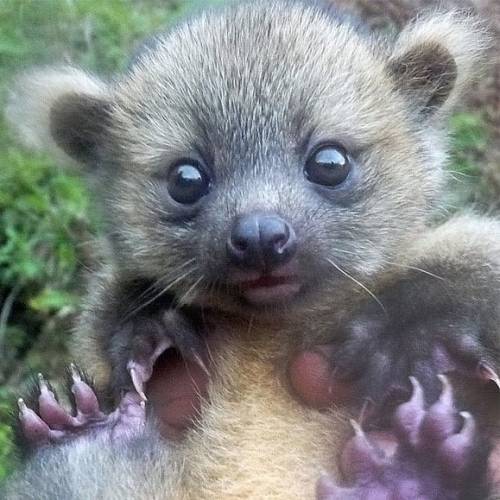#newspecies
I spent my day working on describing new species of Rhombophryne, the ‘diamond frogs’ of Madagascar. I’ve been working on these frogs since 2013, and have described more than half of the currently known species, but there are still so many species to describe.
Here, I am working on the second most important part of the description of one new species: the holotype description. This involves very careful examination and description of the features of the one specimen that ‘carries’ the name of the species. As you can see, I talk with myself a lot while I am doing this. I’m noting aloud features that are substantially different from other species, or things that are worth describing. I find this quite the best way to keep the features in my mind while I am looking at a lot of things at once—but of course it only works while I have my office to myself.
The *most* important part of every species description is the diagnosis. This includes the list of features that are the ones that ‘define’ your new species, and in many cases also the way that it can be told apart from all the other relevant species. In the case of the paper I am working on here, that is the last thing I will be doing for each species, as it will depend on having everything described and ready beforehand.
I am thrilled to introduce Madagascar’s newest frog species, Rhombophryne ellae! This new diamond frog is presumed to be endemic to Montagne d’Ambre National Park in the far north of Madagascar. Its uniquely orange legs and large black hip markings set it apart from all other Rhombophryne species so far. I have the great pleasure of dedicating the new species to my partner, Dr Ella Z. Lattenkamp, in appreciation of her support of my work, and celebration of her recent PhD defence! You can read about the new species and get a link to the #OA paper published in Zoosystematics and Evolution on my blog at http://www.markscherz.com/archives/4598 (link in bio)
.
.
.
.
.
.
.
.
#frogs #Madagascar #newspecies #diamondfrog #Rhombophryne #science #taxonomy #systematics #research #herpetology #wildlife #animals #zoology #Microhylidae #rainforest #frog #diversity #vertebrate #Malagasy #amphibian #beautiful #cute #animal #amphibians #naturalworld #herping #fieldwork #wildlifephotography #species
https://www.instagram.com/p/CBdpa_pMplR/?igshid=5vo2pwu4ug5g
Post link


New species of limu (algae) were recently discovered in the coral reef twilight zone of Papahānaumokuākea Marine National Monument. Martensia lauhiekoeloa (first image) and Martensia abbottiae (second image) received Hawaiian names as their formal scientific species descriptions.
https://www.papahanaumokuakea.gov/new-news/2022/03/23/new-limu-names/
OMG you guys!!! I think I discovered a new species of bird! What do you think it is? #birdsofinstagram #newspecies #dailywalk
https://www.instagram.com/p/BmgQCRxHTUS/?utm_source=ig_tumblr_share&igshid=oe0xh9wcabhp
Post link
NAME THIS FROG
One of the treasures of discovering a new species is that you get to name it.
Well, in this case, that could be you.
I’ve heard of organizations auctioning off new species, such as the new dracula orchid species Leonardo DiCaprio named after his mother, but this is the first time I’ve heard of one being left up to chance… in the form of a raffle.
Each $1 gets you a shot at naming this new species of frog, found in the cloud forests of western Colombia.
This tiny amphibian, the length of a paper clip, depends on horizontal rain for survival in the cloud forest habitat. Females lay eggs in bromeliads or forest litter where water accumulates. Unlike other frog species, this one bypasses the tadpole stage to emerge as fully formed miniature froglets.
The raffle will close at the stroke of midnight Dec 31st, along with this bizarre year.
The winner will be called January 1st, where they will get to choose the new name, for the new frog, in the new year.
All of the money raised will go to preserving the cloud forest this frog and many other rare and endangered species call home.
Ribbit.
@bioconservancy
#newspecies #frog #cloudforest #namethisspecies #biodiversity #conservation #colombia #southamerica
https://www.instagram.com/p/CIQbs2dBVpe/?igshid=klwq2e16cupl
Post link
The photo shoot would have been a lot more enjoyable if I didn’t know they were going to kill the model at the end of it.
He looked so handsome against the white, well-lit backdrop. The glowing box he was inside illuminated his long, elegant tail as he tilted his head inquisitively for his close-up.
It’s for a good cause, “for science,” Luis Mazariegos PhD, reassured me.
Earlier during lunch, the three park guards excitedly rushed back through the muck, disembarking from their fully swamped rubber boots at the entrance to the main lodge, placing an assortment of plastic containers on the table in front of us. They had found the lizards they were looking for: 6 specimens to be the representatives of a new species. I peered into the container to see their darkly colored scales, punctuated by a flashy racing stripe down the middle of their backs, extending all the way to the tip of their tapered, whip-like tails, fading from vibrant orange to sage green. Except, that is, for the fatter, older male who appeared to be in the process of growing his tail back. He clearly narrowly escaped death at least once already and what re-emerged as his tail looked more like a stubby wizard’s hat extending out behind him.
@bioconservancy
#thehummingbirdconservancy #newspecies #endemic #cloudforest #conservation #colombia #science (at Reserva Natural Mesenia - Paramillo)
https://www.instagram.com/p/CHsWFfkhQoH/?igshid=18qyk316zjh0p
Post link
Meet the olinguito, Bassaricyon neblina, the newest and smallest documented member of the family Procyonidae, which it shares with raccoons, coatis, kinkajous and olingos.
“Neblina,” the species name, comes from the spanish word for mist, due to the misty cloud forests the animal inhabits.
This one is a baby, and therefore offensively cute. The photo was taken within The Hummingbird Conservancy’s Messina-Paramillo Reserve in Colombia by Juan Rendon.
Olinguitos had been around for a while, but we didn’t realize they were a different species. I particularly enjoy this excerpt from the wikipedia page detailing our ignorance:
“Olinguitos were regularly seen and even publicly exhibited decades before they were recognized as members of a new species. The animal had previously been confused with its taxonomic cousins, the olingos. One such example was Ringerl, an olinguito who lived in the National Zoo in Washington, D.C., for a year and also toured many other zoos. Researchers unsuccessfully tried to breed her with olingos, not realizing she was a different species. Ringerl died in 1976.”
When it was announced that this was,indeed, a new species in 2013, scientists had no clue what the life of this creature in the wild was like: what it ate, how big it’s home range was, whether they were social, how many offspring it had and how often, etc.
But Uriel, the ex-hunter knew. He knew all about them and could spot them better than anyone.
@bioconservancy
#olinguito #bassaricyon #newspecies #procyon #conservation #colombia #biodiversity #neblina
https://www.instagram.com/p/CHfc-fbh0x3/?igshid=f849aszrvdfz
Post link
Meet the olinguito, Bassaricyon neblina, the newest and smallest documented member of the family Procyonidae, which it shares with raccoons, coatis, kinkajous and olingos.
“Neblina,” the species name, comes from the spanish word for mist, due to the misty cloud forests the animal inhabits.
This one is a baby, and therefore offensively cute. The photo was taken within The Hummingbird Conservancy’s Messina-Paramillo Reserve in Colombia by Juan Rendon.
Olinguitos had been around for a while, but we didn’t realize they were a different species. I particularly enjoy this excerpt from the wikipedia page detailing our ignorance:
“Olinguitos were regularly seen and even publicly exhibited decades before they were recognized as members of a new species. The animal had previously been confused with its taxonomic cousins, the olingos. One such example was Ringerl, an olinguito who lived in the National Zoo in Washington, D.C., for a year and also toured many other zoos. Researchers unsuccessfully tried to breed her with olingos, not realizing she was a different species. Ringerl died in 1976.”
When it was announced that this was,indeed, a new species in 2013, scientists had no clue what the life of this creature in the wild was like: what it ate, how big it’s home range was, whether they were social, how many offspring it had and how often, etc.
But Uriel, the ex-hunter knew. He knew all about them and could spot them better than anyone.
@bioconservancy
#olinguito #bassaricyon #newspecies #procyon #conservation #colombia #biodiversity #neblina
https://www.instagram.com/p/CHfcqMFBfia/?igshid=io4gojz7yxdm
Post link






